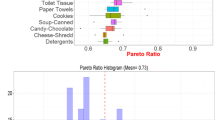Abstract
We study the relationship between purchase frequency and volume and choice behavior as summarized by brand preferences and price sensitivity. Our most striking finding is that consumers with high purchase frequency or high purchase volume are much more price sensitive and have more sharply defined preferences for national brands than consumers with low frequency or low volume of purchase. In much of the choice literature, analysis is confined to households that have on average a larger number of purchases than is representative of the ERIM panel. Our findings suggest that some caution should be exercised in interpreting studies that employ purchase-frequency or purchase-number sample inclusion rules. Our findings also support an information theoretic point of view in which households become more price sensitive via costly acquisition of information about the distribution of prices.
Similar content being viewed by others
References
Allenby, G.M., and P.J. Lenk. (1992). “Modeling Household Purchase Behavior.” Working paper, Ohio State University.
Allenby, G.M., and P.J. Lenk. (1993). “Challenging Conventional Wisdom About Price Sensitivity, Advertising Effects and Brand Loyalty.” Paper presented at the Marketing Science Conference in St. Louis.
Allenby, G.M., and P.E. Rossi. (1991). “Quality Perceptions and Asymmetric Switching Between Brands,”Marketing Science 10, 185–204.
Chintagunta, P.K. (1992). “Estimating a Multinomial Probit Model of Brand Choice Using the Method of Simulated Moments,”Marketing Science 11, 386–407.
Gonul, F., and K. Srinivasan. (1993a). “Consumer Purchase Behavior in a Frequently Bought Product Category: Estimation Issues and Managerial Insights from a Hazard Function Model with Heterogeneity,”JASA, forthcoming.
Gonul, F., and K. Srinivasan. (1993b). “Modeling Unobserved Heterogeneity in Multinomial Logit Models: Methodological and Managerial Issues,”Marketing Science, 12(3), 213–229.
Guadagni, P.M., and J.D.C. Little. (1983). “A Logit Model of Brand Choice Calibrated on Scanner Data,”Marketing Science 2(3), 203–238.
Heckman, J. (1982). “Statistical Models for the Analysis of Discrete Panel Data.” In C. Manski and D. McFadden (eds.),Structural Analysis of Discrete Data: With Econometric Applications. Cambridge, MA: MIT Press.
Kamakura, W.A., and G.J. Russell. (1989). “A Probabilistic Choice Model for Market Segmentation and Elasticity Structure,”Journal of Marketing Research 26(4), 379–390.
Kim, B., R. Blattberg, and P. Rossi. (1992). “Modelling the Distribution of Price Sensitivity and Implications for Optimal Retail Pricing.” Working paper, University of Chicago.
Krishnamurthi, L., and S. Raj. (1991). “Brand Loyalty and Consumer Price Sensitivity,”Marketing Science 10, 172–183.
McCulloch, R., and P. Rossi. (1993). “An Exact Likelihood Analysis of the Multinomial Probit Model,”Journal of Econometrics, forthcoming.
Narasimhan, C., and T. Renken. (1991). “The Representativeness of Panel Members' Purchase Behavior.” Working paper, Olin School of Business, Washington University.
Papatla, P., and L. Krishnamurthi. (1992). “A Probit Model of Choice Dynamics,”Marketing Science 11, 189–206.
Pratt, J.W., and R. Schlaifer. (1984). “On the Nature and Discovery of Structure,”JASA 79, 9–21.
Rossi, P., and G. Allenby. (1993). “A Bayesian Method of Estimating Household Parameters,”Journal of Marketing Research 30, 271–282.
Schwarz, G. (1978). “Estimating the Dimension of a Model,”Annals of Statistics 6, 461–464.
Author information
Authors and Affiliations
Additional information
We acknowledge helpful comments from Greg Allenby and Bob Blattberg. Support from the Micro-Marketing Project at the Graduate School of Business at the University of Chicago is gratefully acknowledged. Byung-Do Kim is the corresponding author.
Rights and permissions
About this article
Cite this article
Kim, BD., Rossi, P.E. Purchase frequency, sample selection, and price sensitivity: The heavy-user bias. Marketing Letters 5, 57–67 (1994). https://doi.org/10.1007/BF00993958
Issue Date:
DOI: https://doi.org/10.1007/BF00993958




